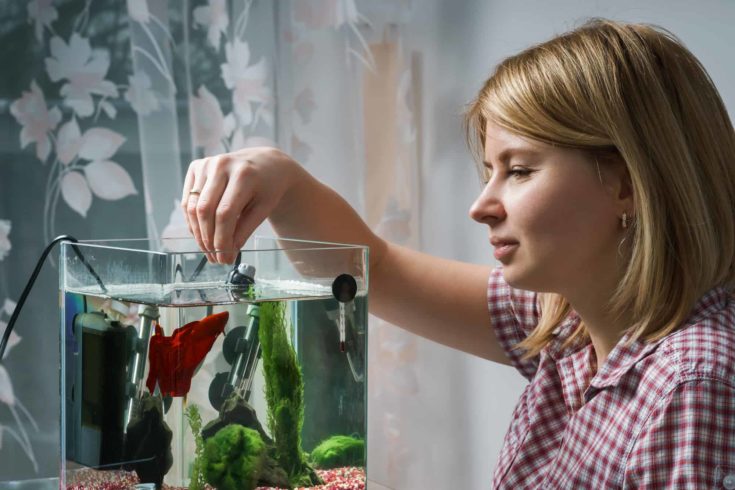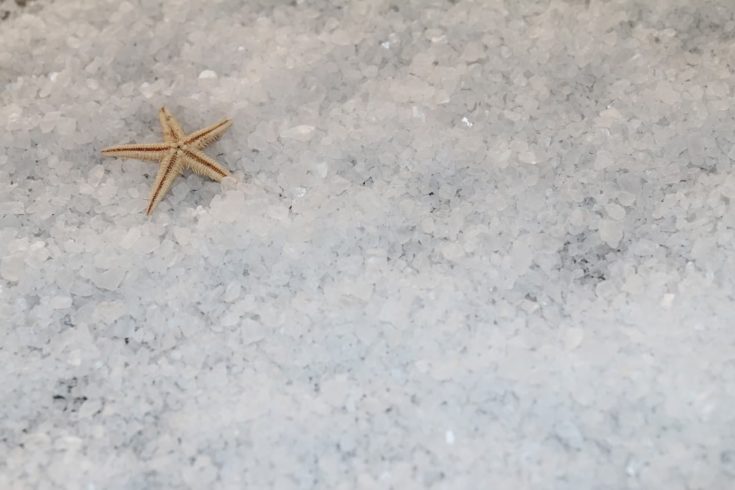Oh no! Has your betta been looking a little under the weather? And what’s that gold rust on the surface of its body? Unfortunately, velvet is a common disease among bettas. Bettas kept in community tanks are particularly susceptible as velvet is highly contagious.
When it comes to treating velvet disease, timeliness is key. In this article, we explore how to treat velvet betta before the illness progresses to an advanced stage. We will also take a look at some of its common causes – prevention is better than cure, after all!
What Is Velvet Disease?
Velvet disease, sometimes known as Oodinium, gold rust, or simply just rust, is a disease that afflicts both freshwater and saltwater fish. True to its name, it appears as a sprinkling of gold rust on your fish’s skin.
Both freshwater and marine fish can be afflicted by velvet disease, though it is more commonly found in freshwater fish such as bettas.
Can velvet disease come from bacteria or a virus?
No. Velvet disease is a type of parasitic infection.
Difference between velvet and bacterial infection: The parasites causing velvet disease are structurally complex and will die within 48 hours if they do not find a host. Meanwhile, bacterial colonies can survive indefinitely in the surrounds of the tank, even without a host.
Difference between velvet and viral infection: Viruses require a host to reproduce, while the parasite that causes velvet reproduces asexually outside the host. Viruses also attack a very specific set of cell types, while velvet attacks a broader range of cells.
What parasite causes Betta Velvet?
The class of parasites that causes the Betta Velvet Disease goes by several names. They were once classified as Oodinium, but have since been renamed Piscinoodinium because they are partially photosynthetic. Here are some species of velvet-causing parasites that belong in the Piscinoodinium family:
- P. limneticum
- P. crepidoodinium
- P. pillularis
- P. amyloodinium
All parasites in this family act in a manner that is similar to Ich. The parasites responsible for both diseases go through a similar life cycle.
Life Cycle
The life cycle of the piscinoodinium parasite is marked by four distinct phases. Though a fish is usually diagnosed with velvet disease in the parasite’s feeding stage, efforts to treat and prevent the disease are more successful when they take place earlier.
Here are the four stages of a piscinoodinium parasite’s life cycle:
The Four Stages
Stage 1: Reproductive Stage
A parent tomont is typically found on the waterbed of an aquarium or any body of water. They reproduce asexually via binary fission, with each tomont undergoing as many as 8 rounds of divisions, ultimately producing up to 256 tomites.
Stage 2: Infective Stage
Tomites are the free-swimming juveniles of tomonts. Tomites are also known as dinospores. They have up to 48 hours to find a live host, during which they rely on photosynthesis for survival. Tomites who fail to find a host in 48 hours will die. Once they latch onto a fish, the parasite becomes known as trophonts.
Stage 3: Feeding Stage
Trophonts attach themselves onto the slime coat of the fish, penetrating its skin and gills. They gnaw on the skin and gill lining of your fish, causing your fish’s immune system to encase these trophonts in a dome-like bubble that resembles gold rust. It is at this stage that fish become diagnosed with velvet disease.
Stage 4: Maturity
Trophonts take around 6 days to mature under tropical conditions. This process can be sped up in water with high temperatures, and will take place more slowly in cooler waters. After trophonts mature, they escape from the gold, dome-like bubbles created by their hosts. They then reenter the reproductive stage as tomonts, kick-starting the cycle all over again.
Is Velvet Fatal?
The good news is, velvet is not fatal!
However, here’s the caveat – you need to catch it early enough. We will cover the full list of symptoms in a section below, but here’s our top tip on catching velvet early – keep a lookout for itching!
Before cysts form and create the gold-rust appearance often associated with velvet, your betta will swim against objects in an attempt to dislodge the parasite. This is one of the earliest signs of velvet, and you should do your utmost to commence treatment at this stage.
How Contagious Is Velvet?
Velvet is a highly contagious disease. Once your betta has been diagnosed with velvet disease, you need to keep a close eye on your betta’s tank mates for the early symptoms of velvet. This is extra important because piscinoodinium parasites are not visible to the naked eye. The disease is also easier to treat in its earlier stages.
What Are The Symptoms Of Betta Velvet?
It is important to catch betta fish velvet early to maximize your chances of treating it. Unfortunately, most cases of velvet disease are diagnosed only after the disease has progressed to an advanced stage. To help you identify the early, mid, and late stages of betta velvet disease, here are some symptoms to expect as the disease progresses:
Early Stage: Scratching
Velvet disease in bettas typically begins in the gills. At this stage, your fish will attempt to dislodge the trophonts that have attached themselves to your fish’s slime coat and gills. To do so, they will rub their bodies against hard or jagged objects in the tank, such as tank decor.
Early-to-Mid Stage: Lethargy
As the disease progresses, your fish will begin to demonstrate behavioral changes, such as sluggishness and loss of appetite. The loss in appetite may also cause weight changes. These are all typical signs of lethargy, and are a good indicator that your fish is ill.
Mid-to-Late Stage: Changes in Breathing and Swimming Patterns
While the early symptoms of betta velvet were behavioral in nature, this mid-to-late stage of the disease starts to manifest as physical changes. You may begin to observe the following: loss of color, fins clamped against the body, and labored breathing. These changes indicate that the parasite has successfully burrowed its way into the slime coat of your betta.
Late Stage: Gold Rust and Skin Peeling
Though gold rust is a key indicator of velvet disease, it unfortunately indicates that the disease has progressed to an advanced stage. The appearance of gold rust shows that protective cysts have formed over the parasites, making them harder to kill. In severe cases, your fish’s skin may also peel off as its tissues become injured.
How Can You Prevent Betta Velvet?
Though betta velvet is entirely treatable, we always advocate for prevention over cure. This is especially the case in this instance, because betta velvet disease can be rather difficult to spot and diagnose. Here are a few key precautions to take in preventing betta velvet disease:
Maintain High Water Quality

Most parasites thrive in poor water conditions, and the piscinoodinium parasite is no different. Therefore, it is essential for you to test your water frequently and make sure that all parameter readings are healthy.
Cleaning your tank regularly is a good way to keep things under control. Using a filter for your betta tank can also make it easier for you to keep water conditions healthy. Optimal water conditions also strengthen the immune system of your fish, making them less susceptible to illnesses.
Quarantine New Arrivals
Velvet is a contagious disease that can spread from fish-to-fish. Therefore, you should always quarantine new arrivals before placing them in your main display tank. To do so, simply set up a separate tank with water conditions that are similar to your main display tank.
Then, place your fish in the quarantine tank, and observe them for 14 days. The symptoms of velvet would become apparent within this timeframe if your new fish are ill.
Feed Your Fish A Good-Quality Diet

Bettas require a balanced, good quality diet to maintain their appearance, health and immunity. Their natural diets consist primarily of protein sources with a small quantity of plant matter.
Replicating these dietary conditions in a captive environment involves selecting good-quality betta food, and supplementing their diets with live protein sources such as bloodworms and brine shrimp. Bettas who enjoy a good-quality diet are less likely to fall prey to red velvet disease.
How Do You Treat Betta Velvet?
Unfortunately, taking precautionary measures doesn’t eliminate the risk of your betta falling ill. In spite of your best efforts, your betta may still be infected by velvet disease. If you find yourself in this situation, here are some measures you can take to treat your fish!
Steps To Treat Velvet
Before dosing your tank with medication, there are several things you can do to maximize your bettas odds of recovery. The steps below facilitate the healing process by interfering with the life cycle of the parasites.
Dimming The Lights
Piscinoodinium parasites are partially photosynthetic, so dimming the lights will lower the parasite’s odds of survival. The juvenile tomites rely on photosynthesis for survival before attaching to a live host.
By limiting their ability to perform photosynthesis at this stage, tomites are more likely to die before finding a live host. This prevents your betta from being infected by velvet disease.
Raising The Water Temperature
If your fish has already been infected by the parasite, raising the water temperature in your tank to 82 degrees Fahrenheit can accelerate the life cycle of the trophont. This means that the trophont will mature a lot quicker, and detach itself from your fish within a shorter period of time.
Keep in mind that your fish and tank will still need to be treated even after the trophonts have left your fish. Mature trophonts turn into parent tomonts that will kickstart the infectious cycle all over again. To protect your betta and its tankmates, you need to dose your tank and get rid of the parasites completely.
Add Aquarium Salt
Velvet disease can impact gill function, and this is where aquarium salt comes in. Adding between 1 teaspoon of salt per gallon of water will improve your fish’s ability to osmoregulate. This in turn reduces stress and improves gill function.

Aquarium salt also gently irritates your betta’s slime coat, causing it to produce a thicker layer of mucus that can prevent or minimize the damage caused by the parasites.
Medication for Betta Velvet Disease
Once your betta has been infected by velvet disease, it is important to medicate your fish as quickly as possible. This maximizes your betta’s odds of recovery. The vast majority of treatment aims to eliminate the parasite at its free-swimming stage.
Before adding any treatment to your tank, it is crucial to discontinue carbon filtration. All sources of activated carbon should be removed from the water, as it will absorb any drugs you dose your tank with.
Here are some forms of medication that are commonly used in treating betta fish velvet:
Copper Sulfate
Copper sulfate is a highly recommended treatment for velvet disease because it is effective against most external parasites. In the case of velvet disease, it acts by attacking the tomites in their free-swimming stage.
There are a myriad of copper sulfate-based treatments on the market, and you should dose your tank according to each manufacturer’s instructions. To completely eliminate the parasites from your tank, use this treatment for 14 days.
Pro Tip
Copper sulfate can kill invertebrates, so be sure to relocate them before commencing copper sulfate treatment.
Malachite Green
Malachite green is a potent treatment that is highly effective against external parasites in fish. Therefore, it has been successfully used to treat velvet disease in bettas.
Because of its strength, it is important to take your fish’s age and overall health into consideration before opting for this treatment method. Remember not to overmedicate – this is especially important given malachite green’s harsh properties.
Atabrine
Atabrine, sometimes known as mepacrine or quinacrine hydrochloride, is an anti-malaria drug that has been successfully used in treating parasitic infections in fish. Because atabrine is a legacy drug, it can be pretty difficult to locate. The recommended dose is 3mg per liter of water, for 3 consecutive days.
Keep in mind that a turbine can be broken down by direct overhead light. This means that the lights in your aquarium should be turned off while treatment is ongoing.
How Long Will It Take To Treat Velvet?
Completely removing velvet from your tank is a process that can take between 3-4 weeks as you may need to remove multiple generations of parasites from your tank.
Once the parasite has found a host, it can live for up to two weeks. In the interim, tomonts may continue producing daughter tomites, which will perpetuate the cycle of infection. Effectively ridding your tank of velvet disease means eliminating all traces of the parasite from your tank.
Betta Velvet Checklist
- Quarantine new arrivals
- Maintain healthy water parameters
- Learn to spot the early signs of betta velvet disease
- Commence treatment as quickly as possible
- Eliminate all traces of the parasite from the tank to prevent re-infection
Conclusion
Betta velvet may be contagious, but it doesn’t have to be fatal. The prognosis of the disease is generally positive as long as you catch it early and treat it appropriately.
Remember that it is always far better to do all you can to prevent the onset of the disease in the first place. Steps such as quarantining new arrivals, keeping your tank clean and feeding your fish well can go a long way.
Did you find this article helpful? If you did, don’t forget to share it with a friend, and let us know your thoughts in the comments below!
